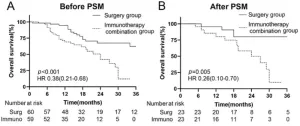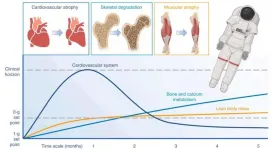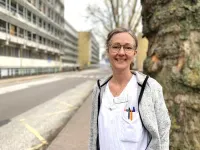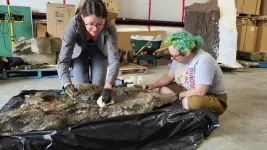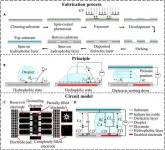(Press-News.org) Whether it’s for your vehicle or your home, from small-scale uses to the largest, the debate over the most efficient and cost-effective fuels continues. Currently, there’s no shortage of options either.
Nuclear power provides an alternative to more conventional energy options but requires rigorous systems monitoring and safety procedures. Machine learning could make keeping a close eye on key elements of nuclear systems easier and response time to issues faster.
Syed Bahauddin Alam, an assistant professor in the Department of Nuclear, Plasma & Radiological Engineering (NPRE) in the Grainger College of Engineering at the University of Illinois Urbana-Champaign, and his team worked with artificial-intelligence and machine-learning experts through Illinois Computes to develop a novel method for real-time monitoring of nuclear energy systems that can infer predictions about 1,400 times faster than traditional Computational Fluid Dynamics (CFD) simulations. NCSA research assistants and NPRE graduate students Kazuma Kobayashi and Farid Ahmed assisted in the development.
Published in Nature’s npj Materials Degradation, Alam’s research introduces machine learning-driven virtual sensors based on deep-learning operator-surrogate models as a complement to physical sensors in monitoring critical degradation indicators. Traditional physical sensors face limitations, particularly in measuring critical parameters in hard-to-reach or harsh environments, which often result in incomplete data coverage. Moreover, traditional physics-based numerical modeling methods, such as CFD, are still too slow to provide real-time predictions in nuclear power facilities.
Instead, the novel Deep Operator Neural Networks (DeepONet), when properly trained on graphics processing units (GPUs), can instantly and accurately predict complete multiphysics solutions on the entire domain. DeepONet functions as real-time virtual sensors and addresses these limitations of physical sensors or classical modeling predictions, specifically by predicting key thermal-hydraulic parameters in the hot leg of a pressurized water reactor.
Because components are continuously subjected to extreme temperatures, pressures and radiation, proper monitoring and inspection of in-service elements of nuclear reactors is essential for long-term safety and efficiency. AI isn’t replacing human oversight but creating new ways to monitor and predict the potential failure of system elements.
“Our research introduces a new way to keep nuclear systems safe by using advanced machine-learning techniques to monitor critical conditions in real-time,” Alam said. “Traditionally, it’s been incredibly challenging to measure certain parameters inside nuclear reactors because they’re often in hard-to-reach or extremely harsh environments. Our approach leverages virtual sensors powered by algorithms to predict crucial thermal and flow conditions without needing physical sensors everywhere.
“Think of it like having a virtual map of how the reactor is operating, giving us constant feedback without having to place physical instruments in risky spots. This not only speeds up the monitoring process but also makes it significantly more accurate and reliable. By doing this, we can detect potential issues before they become serious, enhancing both safety and efficiency.”
Through the campus-funded Illinois Computes program, Alam utilized allocations on NCSA’s Delta, performing computations for data generation on central processing unit (CPU) nodes, and for the training and evaluation tasks on a computational node with NVIDIA A100 GPUs. He collaborated with NCSA’s experts in AI-driven scientific computing and high-performance computing.
Massive thanks to Illinois Computes for funding this research. Partnering with Dr. Diab Abueidda and Dr. Seid Koric from NCSA was essential to our success. Through the campus-funded program, we leveraged Delta’s state-of-the-art supercomputing resources, including a computational node with NVIDIA A100 GPUs, to train and test our models efficiently. The NCSA technical staff provided invaluable support throughout the entire process, demonstrating the tremendous impact of combining AI with high-performance computing to advance nuclear safety. We will continue to work on unleashing the power of AI in complex energy systems, pushing the boundaries of what is possible to enhance safety, efficiency and reliability.
Syed Bahauddin Alam, assistant professor in the Department of Nuclear, Plasma & Radiological Engineering
“In this Illinois Computes project, we have fully utilized the unique high-performance computing resources and multidisciplinary expertise at NCSA and the Grainger College of Engineering to advance translational and transformative engineering research in Illinois,” said Seid Koric, senior technical associate director for Research Consulting at NCSA and research professor at the Department of Mechanical Science and Engineering.
“This collaboration exemplifies the synergy that emerges when advanced AI methods, high-performance computing resources and domain expertise converge,” said Abueidda, a research scientist at NCSA. “Working alongside Dr. Alam’s team and NCSA’s AI and HPC experts, we leveraged the U.S. National Science Foundation-funded Delta’s cutting-edge capabilities to push the boundaries of real-time monitoring and predictive analysis in nuclear systems. By uniting our specialized skill sets, we have accelerated research while enhancing the accuracy and reliability of critical safety measures.
“We look forward to continuing this interdisciplinary approach to drive transformative solutions for complex energy systems. Ultimately, these breakthroughs highlight the promise of computational science in addressing the pressing challenges of nuclear energy.”
ABOUT DELTA AND DELTAAI
NCSA’s Delta and DeltaAI are part of the national cyberinfrastructure ecosystem through the U.S. National Science FoundationACCESS program. Delta (OAC 2005572) is a powerful computing and data-analysis resource combining next-generation processor architectures and NVIDIA graphics processors with forward-looking user interfaces and file systems. The Delta project partners with the Science Gateways Community Institute to empower broad communities of researchers to easily access Delta and with the University of Illinois Division of Disability Resources & Educational Services and the School of Information Sciences to explore and reduce barriers to access. DeltaAI (OAC 2320345) maximizes the output of artificial intelligence and machine learning (AI/ML) research. Tripling NCSA’s AI-focused computing capacity and greatly expanding the capacity available within ACCESS, DeltaAI enables researchers to address the world’s most challenging problems by accelerating complex AI/ML and high-performance computing applications running terabytes of data. Additional funding for DeltaAI comes from the State of Illinois.
ABOUT ILLINOIS COMPUTES
Illinois Computes offers computing and data storage resources, technical expertise and support services to researchers from all domains across the University of Illinois Urbana-Champaign campus. Through the campus-funded program, NCSA will learn what additional assets are needed to fulfill the computing demands of the university and adjust the cyberinfrastructure strategy while continuing to make access to systems, interdisciplinary and technical knowledge, and support infrastructure easy to obtain. Illinois Computes removes barriers for all Illinois researchers – especially those typically underserved – to access NCSA’s growing assemblage of research computing tools and world-class staff, furthering their innovative and novel work while ensuring NCSA is a leader in the global research community.
Check out the Illinois Computes website and sign up for the monthly newsletter for more information.
END
Using AI to monitor inaccessible locations of nuclear energy systems
2025-04-14
ELSE PRESS RELEASES FROM THIS DATE:
Outcomes for advanced hepatocellular carcinoma with pulmonary metastasis: Surgical vs. immunotherapy
2025-04-14
Hepatocellular carcinoma (HCC) is a leading cause of cancer-related deaths worldwide, with over 70% of patients diagnosed at an advanced stage due to the absence of symptoms. A key characteristic of advanced HCC is extrahepatic metastasis, particularly pulmonary metastasis, which is associated with a poor prognosis.
Although multitargeted tyrosine kinase inhibitors (TKIs) and immune checkpoint inhibitors have limited efficacy when used alone in advanced HCC, their combination can enhance outcomes for patients with pulmonary metastases. Meanwhile, pulmonary metastasectomy ...
How flexible wearables protect astronauts' health in space
2025-04-14
A review published recently in Wearable Electronics examines the current applications and persistent challenges of flexible wearable technologies in aerospace medicine. As human space exploration progresses toward extended-duration missions, the imperative for real-time monitoring of astronauts' physiological and psychological well-being has become increasingly critical. The unique space environment characterized by microgravity conditions, cumulative radiation exposure, and extreme thermal fluctuations presents multifaceted health risks to crew members.
Flexible wearable systems, equipped ...
Pregnancy complications contribute to cardiovascular risk for overweight women, study finds
2025-04-14
Complications during pregnancy (or adverse pregnancy outcomes), like gestational diabetes and newly developed high blood pressure, act as nature’s stress test and may uncover an individual’s risk for heart disease later in life, according to new research published in the JACC, the flagship journal of the American College of Cardiology. The study also highlights how weight management before pregnancy may not only improve maternal health but also reduce future cardiovascular disease risk.
The observational study, which ...
Simple medication can save the lives of cardiac patients
2025-04-14
Cardiovascular disease is by far the most common cause of death worldwide, and myocardial infarction is the most common acute event. For those who survive a myocardial infarction, the risk of a new heart attack is greatest in the first year after the initial event because the blood vessels are more sensitive, making it easier for blood clots to develop. Reducing the “bad” cholesterol in the blood stabilises changes in the vessels, decreasing the risk for new events. The current established routine treatment is to treat with high-potency statins, immediately after the infarction. However, the majority ...
Combination of drugs could prevent thousands of heart attacks
2025-04-14
LUND UNIVERSITY/IMPERIAL COLLEGE LONDON PRESS RELEASE
[Peer-reviewed /Simulation/Modelling / People]
UNDER EMBARGO UNTIL:
Monday 14th April 2025
10:00 am US Eastern Time / 3:00 pm UK Time
Combination of drugs could prevent thousands of heart attacks
Patients who receive an add-on medication soon after a heart attack have a significantly better prognosis than those who receive it later, or not all.
This is according to a new study from researchers at Lund University in Sweden and Imperial College London. ...
New tool for cutting DNA: Promising prospects for biotechnology
2025-04-14
New tool for cutting DNA: promising prospects for biotechnology
An INRS team discovers a new family of enzymes capable of inducing targeted cuts in single-stranded DNA
A few years ago, the advent of technology known as CRISPR was a major breakthrough in the scientific world. Developed from a derivative of the immune system of bacteria, CRISPR enables double strands of nucleotides in deoxyribonucleic acid (DNA) to be cut. This makes it possible to specifically modify a targeted gene in plant, animal and human cells. Ultimately, CRISPR became a preferred method in the search for treatments for acquired or hereditary diseases.
Recently, ...
Footprints of tail-clubbed armored dinosaurs found for the first time
2025-04-14
Victoria, BC— For the first time, footprints of armoured dinosaurs with tail clubs have been identified, following discoveries made in the Canadian Rockies. The 100-million-year-old fossilized footprints were found at sites at both Tumbler Ridge, BC, and northwestern Alberta.
There are two main groups of ankylosaurs. Nodosaurid ankylosaurs have a flexible tail and four toes, while ankylosaurid ankylosaurs have a sledgehammer-like tail club, and only three toes on their feet.
Unlike the well-known ankylosaur footprints called Tetrapodosaurus ...
Structural optimization of microfluidic chips for enhancing droplet manipulation and observation via electrodynamics simulation
2025-04-14
A research paper by scientists at Beijing Institute of Technology and City University of Hong Kong presented a versatile electrodynamics simulation model designed to analyze the driving forces of partially filled electrodes to optimize the structural parameters of Digital microfluidic chips.
The research paper, published on Mar. 06, 2025 in the journal Cyborg and Bionic Systems, utilizes finite element analysis to determine the voltage distribution within the Digital microfluidic chip and calculates the driving force acting on the droplets using the principles of virtual work.
Digital microfluidic chips (DMCs) have shown huge potential for biochemical analysis ...
Stress, depression factor into link between insomnia, heavy drinking
2025-04-14
COLUMBUS, Ohio – Insomnia and hazardous drinking are so closely intertwined that estimates suggest at least one-third, and as many as 91%, of people who have a hard time with sleep also misuse alcohol.
A new study suggests that perceived stress and depression factor into the relationship between the two conditions – perhaps not a surprise. But because the relationship between insomnia and heavy drinking goes in both directions, the influence of stress or depression depends on which condition came first, the analysis found.
“We were most interested in how insomnia leads to drinking, and we found that seems to occur primarily through ...
Unlocking the genetic basis of animal behavior using fruit flies
2025-04-14
Years of research in the field of genetics have offered interesting insights spanning the origins and development of heredity and traits, offering valuable information on its influence on every aspect of life, right from eye color to susceptibility to certain diseases. But how do our genes influence the way we act, react to threats, and interact with others? Despite the recent advances in genetics, understanding the genetic foundations of behavior remains one of biology’s most fascinating challenges. Scientists have long turned to simpler organisms to help answer these questions, with the humble fruit fly emerging as an ideal candidate. These tiny insects share ...
